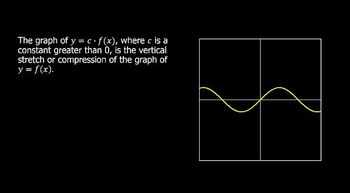Table of contents
- 0. Review of Algebra4h 16m
- 1. Equations & Inequalities3h 18m
- 2. Graphs of Equations43m
- 3. Functions2h 17m
- 4. Polynomial Functions1h 44m
- 5. Rational Functions1h 23m
- 6. Exponential & Logarithmic Functions2h 28m
- 7. Systems of Equations & Matrices4h 6m
- 8. Conic Sections2h 23m
- 9. Sequences, Series, & Induction1h 19m
- 10. Combinatorics & Probability1h 45m
3. Functions
Transformations
Problem 29
Textbook Question
Graph each function. See Examples 1 and 2. h(x)=|-(1/2)x|
 Verified step by step guidance
Verified step by step guidance1
Step 1: Understand the function. The function h(x) = |-(1/2)x| is an absolute value function. The absolute value of a number is its distance from zero on the number line, regardless of direction. Therefore, the graph of an absolute value function always opens upwards or downwards and forms a 'V' shape.
Step 2: Identify the slope and direction. The slope of the function is -1/2. However, because it's an absolute value function, the 'negative' doesn't mean the graph will slope downwards. Instead, it means the graph will be reflected across the y-axis. So, the graph will still open upwards, but it will be a mirror image of the graph of h(x) = |(1/2)x|.
Step 3: Identify the vertex. The vertex of an absolute value function is the point at the bottom of the 'V' (or the top, if the graph opens downwards). For the function h(x) = |-(1/2)x|, the vertex is at (0,0).
Step 4: Plot the graph. Start by plotting the vertex at (0,0). Then, since the slope is -1/2, for every 2 units you move to the right from the vertex, move 1 unit up. Similarly, for every 2 units you move to the left from the vertex, move 1 unit up. Connect the points to form a 'V' shape.
Step 5: Check your graph. The graph should open upwards and be a mirror image of the graph of h(x) = |(1/2)x|. If it doesn't look like this, check your work and try again.
Recommended similar problem, with video answer:
 Verified Solution
Verified SolutionThis video solution was recommended by our tutors as helpful for the problem above
Video duration:
5mPlay a video:
Was this helpful?
Key Concepts
Here are the essential concepts you must grasp in order to answer the question correctly.
Absolute Value Function
The absolute value function, denoted as |x|, represents the distance of a number x from zero on the number line, regardless of direction. This means that the output is always non-negative. For example, |3| = 3 and |-3| = 3. In the context of the function h(x) = |-(1/2)x|, the absolute value affects the shape of the graph, ensuring it is always above the x-axis.
Recommended video:

Function Composition
Linear Functions
Linear functions are mathematical expressions that create a straight line when graphed. They can be represented in the form y = mx + b, where m is the slope and b is the y-intercept. In the function h(x) = |-(1/2)x|, the linear component is -(1/2)x, which indicates a slope of -1/2, meaning the line descends as it moves from left to right before being reflected upwards by the absolute value.
Recommended video:

Linear Inequalities
Graphing Techniques
Graphing techniques involve plotting points on a coordinate plane to visualize mathematical functions. For the function h(x) = |-(1/2)x|, one would first graph the line y = -(1/2)x, then reflect any portions of the graph that fall below the x-axis to create the final graph of the absolute value function. Understanding how to manipulate and reflect graphs is crucial for accurately representing functions involving absolute values.
Recommended video:
Guided course

Graphs and Coordinates - Example

 5:25m
5:25mWatch next
Master Intro to Transformations with a bite sized video explanation from Nick Kaneko
Start learningRelated Videos
Related Practice


























